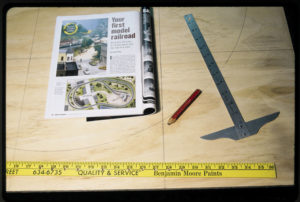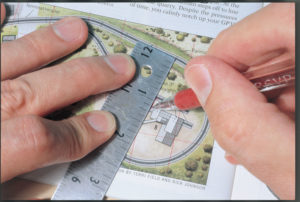How to Draw Model Railroad Track Plans
This unproblematic method lets you scale upward a track plan from a magazine or sketch onto your model train table
You've managed to find the perfect track plan in a volume or magazine, or you've spent hours at the drawing tabular array or estimator carefully drafting a track program. The next footstep is transferring the track plan to your layout tabular array or benchwork.
If you lot've never done this earlier, the beginning thing you'll probably acquire is that – regardless of how carefully you've measured – rail will nigh always have up more room on the layout than it did on paper. Information technology is important to take your time and exist precise, every bit any miscalculation will hinder tracklaying.
Tools and tricks

Photo past Jeff Wilson
One of the fist steps in rails planning is drawing a filigree on the plywood (or whatsoever surface your layout top happens to be). Every bit fig. one shows, a drywall T-foursquare with 4-foot arm is invaluable for this. A 12″ grid is usually sufficient, but for complex plans you might desire to add filigree lines at the 6″ marks besides. It'due south as well important to draw grid lines on the track plan to match those on your layout surface.

Photo by Jeff Wilson
Once the basic grid is drawn on the layout and track plan, the next step is to mark out the radii of curves. Effigy 2 shows how to notice and marking the middle of the radii on the runway programme. Transfer the center point to the layout table, and so apply a compass to transfer the bend to the table.
You can make a big compass past using an old wood yardstick. Holes in the yardstick at 1″ intervals make handy guides for a pencil.

Photo by Jeff Wilson
However, some curves are too broad to easily utilize a yardstick, or the centre of the curve may be well off the layout table. In this example curve templates piece of work well (encounter fig. 3).
My curve templates are about xl″ long and made from large pieces of .060″ styrene that I had on manus. You can besides brand them from hardboard (such as Masonite) or thin plywood. Cardboard volition work, just it is not as durable as hardboard. I made my templates in ii″ intervals from 18″ to 44″, and as the photo shows, at that place is different radius on each side of the template.
Planning turnouts
Probably the most difficult part of runway planning is leaving enough room for turnouts. They always seem to accept up more than space than originally figured, and every manufacturer's turnouts vary slightly in size and shape. Because of this, complex trackwork in published plans often doesn't fit the aforementioned manner on a layout.
To remove the guesswork, make several paper turnout templates by placing turnouts on a photocopier, then running off every bit many copies as y'all demand. Exist sure to label them with the brand name and size.

Photo by Jeff Wilson
Equally you utilise templates, tape them in place, every bit shown in fig. 4. Alignment is the important thing – remember that you can trim turnouts to fit tighter areas as long as you maintain proper alignment and track center spacing.
From newspaper to benchwork
Big rolls of newsprint or dark-brown arts and crafts (or wrapping) paper work well for laying out full-size plans. Yous can do this even before starting benchwork by laying the paper on the floor where the layout will become.
Getting your track programme to the benchwork is a fun step in visualizing what your finished layout will look like. Work carefully and take your time, equally the procedure is vital in getting runway to fit properly, which volition heighten operations and enjoyment.
Source: https://www.trains.com/mrr/how-to/how-to-transfer-a-track-plan-from-paper-to-model-railroad-benchwork/
Post a Comment for "How to Draw Model Railroad Track Plans"